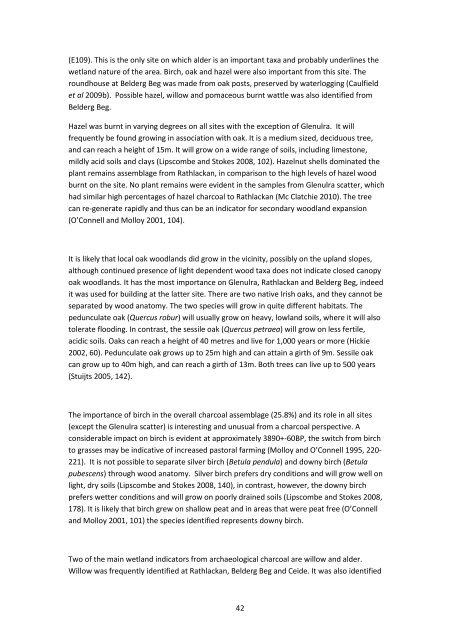Neolithic and Bronze Age Landscapes of North Mayo: Report 2011
Neolithic and Bronze Age Landscapes of North Mayo: Report 2011
Neolithic and Bronze Age Landscapes of North Mayo: Report 2011
You also want an ePaper? Increase the reach of your titles
YUMPU automatically turns print PDFs into web optimized ePapers that Google loves.
(E109). This is the only site on which alder is an important taxa <strong>and</strong> probably underlines the<br />
wetl<strong>and</strong> nature <strong>of</strong> the area. Birch, oak <strong>and</strong> hazel were also important from this site. The<br />
roundhouse at Belderg Beg was made from oak posts, preserved by waterlogging (Caulfield<br />
et al 2009b). Possible hazel, willow <strong>and</strong> pomaceous burnt wattle was also identified from<br />
Belderg Beg.<br />
Hazel was burnt in varying degrees on all sites with the exception <strong>of</strong> Glenulra. It will<br />
frequently be found growing in association with oak. It is a medium sized, deciduous tree,<br />
<strong>and</strong> can reach a height <strong>of</strong> 15m. It will grow on a wide range <strong>of</strong> soils, including limestone,<br />
mildly acid soils <strong>and</strong> clays (Lipscombe <strong>and</strong> Stokes 2008, 102). Hazelnut shells dominated the<br />
plant remains assemblage from Rathlackan, in comparison to the high levels <strong>of</strong> hazel wood<br />
burnt on the site. No plant remains were evident in the samples from Glenulra scatter, which<br />
had similar high percentages <strong>of</strong> hazel charcoal to Rathlackan (Mc Clatchie 2010). The tree<br />
can re-generate rapidly <strong>and</strong> thus can be an indicator for secondary woodl<strong>and</strong> expansion<br />
(O’Connell <strong>and</strong> Molloy 2001, 104).<br />
It is likely that local oak woodl<strong>and</strong>s did grow in the vicinity, possibly on the upl<strong>and</strong> slopes,<br />
although continued presence <strong>of</strong> light dependent wood taxa does not indicate closed canopy<br />
oak woodl<strong>and</strong>s. It has the most importance on Glenulra, Rathlackan <strong>and</strong> Belderg Beg, indeed<br />
it was used for building at the latter site. There are two native Irish oaks, <strong>and</strong> they cannot be<br />
separated by wood anatomy. The two species will grow in quite different habitats. The<br />
pedunculate oak (Quercus robur) will usually grow on heavy, lowl<strong>and</strong> soils, where it will also<br />
tolerate flooding. In contrast, the sessile oak (Quercus petraea) will grow on less fertile,<br />
acidic soils. Oaks can reach a height <strong>of</strong> 40 metres <strong>and</strong> live for 1,000 years or more (Hickie<br />
2002, 60). Pedunculate oak grows up to 25m high <strong>and</strong> can attain a girth <strong>of</strong> 9m. Sessile oak<br />
can grow up to 40m high, <strong>and</strong> can reach a girth <strong>of</strong> 13m. Both trees can live up to 500 years<br />
(Stuijts 2005, 142).<br />
The importance <strong>of</strong> birch in the overall charcoal assemblage (25.8%) <strong>and</strong> its role in all sites<br />
(except the Glenulra scatter) is interesting <strong>and</strong> unusual from a charcoal perspective. A<br />
considerable impact on birch is evident at approximately 3890+-60BP, the switch from birch<br />
to grasses may be indicative <strong>of</strong> increased pastoral farming (Molloy <strong>and</strong> O’Connell 1995, 220-<br />
221). It is not possible to separate silver birch (Betula pendula) <strong>and</strong> downy birch (Betula<br />
pubescens) through wood anatomy. Silver birch prefers dry conditions <strong>and</strong> will grow well on<br />
light, dry soils (Lipscombe <strong>and</strong> Stokes 2008, 140), in contrast, however, the downy birch<br />
prefers wetter conditions <strong>and</strong> will grow on poorly drained soils (Lipscombe <strong>and</strong> Stokes 2008,<br />
178). It is likely that birch grew on shallow peat <strong>and</strong> in areas that were peat free (O’Connell<br />
<strong>and</strong> Molloy 2001, 101) the species identified represents downy birch.<br />
Two <strong>of</strong> the main wetl<strong>and</strong> indicators from archaeological charcoal are willow <strong>and</strong> alder.<br />
Willow was frequently identified at Rathlackan, Belderg Beg <strong>and</strong> Ceide. It was also identified<br />
42

















